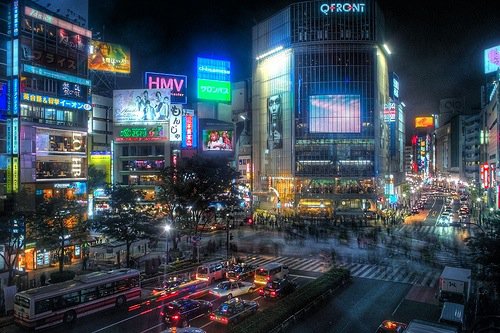Shibuya
Shibuya is a fashion and entertainment wonderland, a Mecca for Tokyo’s youth – but also a major business and transport centre – so plenty of older people hang out here too. When pictures of Tokyo are shown on overseas TV, more often than not it’s Shibuya, as the bright lights and crowds of people are so iconic of the ultimate futuropolis. Stepping out of the station you arrive in Hachiko Square, which is chock full of people at almost any time of day.
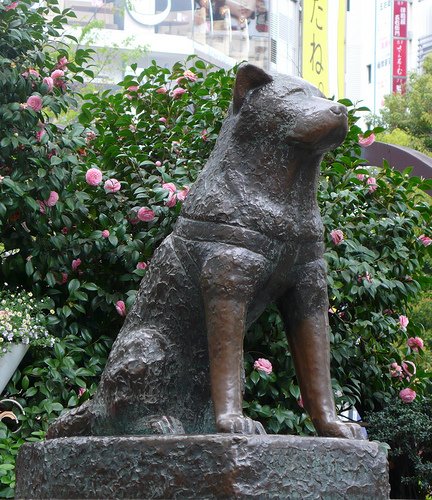
Hachiko calmly watching the crowds passing by
Hachiko was a dog, who came to meet his master at the station every day as he arrived home from work. So loyal was the dog, he continued to come to the station at the same time each day for ten years after his master’s death in 1925. This loyalty was rewarded with a statue in one corner of the square, and Hachiko himself attended the official unveiling in 1934. (He passed away the following year).
So, nowadays Hachiko Square is the place to meet up – if you’re meeting friends in Shibuya you hardly need to say where – everyone will just show up at Hachiko anyway. The only problem with this is the scale of Shibuya – you might find Hachiko, but will you be able to find your friends in the surrounding throng?
To reach the heart of Shibuya you need to make use of the famous Hachiko Scramble – the world’s busiest pedestrian crossing.

Shibuya in the early evening
Huge crowds build up on each side until the lights change, when everyone pours into the road and scrambles their way through to the other side. If you’ve ever felt the slightest hint of agoraphobia anywhere else, you’d be well advised to stay clear, and perhaps simply view the scene from the relative calm of the station.
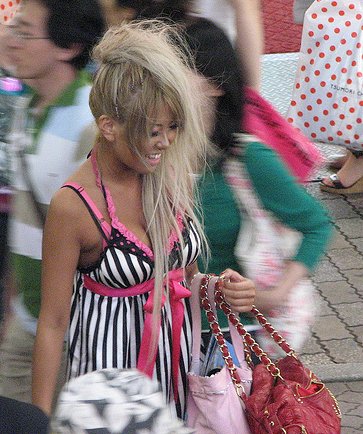
A Shibuya Girl
Japan is a land of subcultures and trends – and more of these are on show in Shibuya than anywhere else. The country’s youth congregate here to declare their individuality, and to rebel against the rules of adult society. Membership of one of a host of ever changing subcultures is advertised through wild clothing and colourful hair. There are Ganguros and Yamanbas with dark tans and pale lipstick, materialistic Gyaru with Louis Vuitton handbags and pale white skin, and surfer babe Kogals in miniskirts and bikini tops, chatting away in their own unique Kogyaru dialect. It’s hard to believe from the scene on the street, but in just a few years most of these kids will move on to join the ranks of conformist company employees and respectable housewives.
Facing Hachiko Square is the building that is more central to the Shibuya fashion scene than anywhere else – Shibuya 109.
A teen girl’s paradise, floor after floor is dedicated to a seemingly endless array of wearable art – and on weekends it’s absolutely mobbed.
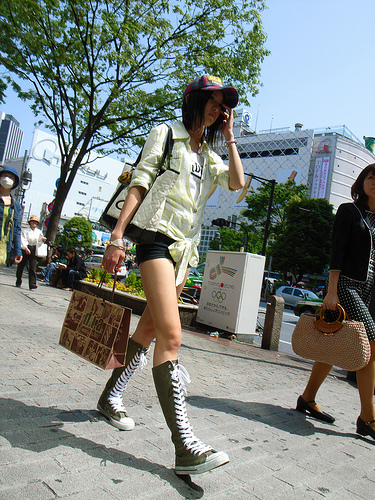
A chic girl strides confidently through Shibuya
It’s well worth a look for an insight into Tokyo youth culture, even if fashion isn’t your thing. And if you’re still not satisfied after visiting here, there are plenty of boutiques on the street and several giant department stores, while just up the road Harajuku caters to the more alternative crowd.
Across the road from the station is Centre Gai, the busiest and most youth-focused street in Shibuya. It’s full of neon lights, advertising boards, and giant TV screens, and is lined with game arcades, music shops, karaoke rooms, and just about every kind of entertainment outlet imaginable. Above and below the shops lie countless eating and nightlife venues.
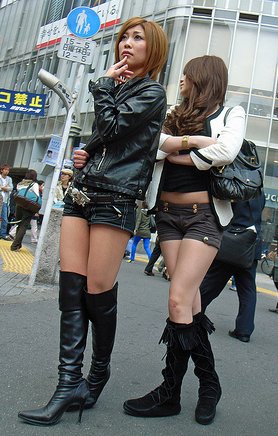
Notice how these girls are using boots to pretend to be taller than they really are
In a way that can seem very strange, and would never be encountered in the UK, most of these establishments are accessed by lift from the street.
A board at the bottom will advertise each venue, and every floor of a high-rise building is often a different eating or drinking venue. As the lift stops at each floor you get a chance to peek into all manner of different establishments.
Most popular, and the best place to drink, are Izakayas – Japanese style pubs where you snack and drink at a low table while sitting on the floor – though there are also plenty of bars, restaurants, nightclubs and music venues. The problem for most visitors will just be working out what each kind of establishment is – though a few minutes scrutiny of the menu should sort this out, as most Japanese menus have pictures of the food – not just descriptions – and thankfully not all of them give their prices using Japanese numerals.
There is so much choice that you can pay almost anything you want for a meal – from a couple of hundred yen for noodles, up to tens of thousands of yen at a high-class eatery.
Around the corner is ‘Love Hotel Hill’ – a district crowded with hotels renting rooms for three hour ‘rests’ as well as overnight stays. Their popularity is simply due to many young Japanese living with their parents, and while most people keep their visits discreet, there is little or no stigma attached to them, and with their wide range of quirky themed rooms, they can make an interesting alternative to a standard hotel. There is just so much stuff and so many people crammed into a tiny area that you could live your whole life in Shibuya and never run out of things to do. The first time visitor is most likely to experience Shibuya as a blur, so great is the sensory overload, but it’s worth visiting just to feel the buzz and the energy of so many people all out to loosen up and have fun. More than anything else, Shibuya is a place of bright colours and loud noises – a non-stop carnival day and night.
Access: Shibuya Station is on the Yamanote, Hanzomon, Fukutoshin and Ginza lines.
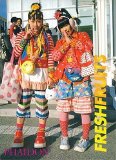 Fresh Fruits
by Shoichi Aoki.
If you like the cover, you’ll love this book – the inside consists of photos of Tokyo kids in equally outrageous outfits – but no two are alike. Both ‘Fresh Fruits’ and its predecessor, ‘Fruits’, contain a dazzling extravaganza of Japanese street fashion that is a delight to browse through time and again.
Fresh Fruits
by Shoichi Aoki.
If you like the cover, you’ll love this book – the inside consists of photos of Tokyo kids in equally outrageous outfits – but no two are alike. Both ‘Fresh Fruits’ and its predecessor, ‘Fruits’, contain a dazzling extravaganza of Japanese street fashion that is a delight to browse through time and again.
 The Tokyo Look Book: Stylish to Spectacular, Goth to Gyaru, Sidewalk to Catwalk
by Philomena Keet and Yuri Manabe.
This book covers the full range of Japan's styles, from cutting edge office wear to Shibuya's street garb. Nowhere else, except in Tokyo itself, could you see such a comprehensive cross-section of Japanese fashion, and the photos are backed up with insightful interviews, and even a guide about where to shop if you want to reproduce each look.
The Tokyo Look Book: Stylish to Spectacular, Goth to Gyaru, Sidewalk to Catwalk
by Philomena Keet and Yuri Manabe.
This book covers the full range of Japan's styles, from cutting edge office wear to Shibuya's street garb. Nowhere else, except in Tokyo itself, could you see such a comprehensive cross-section of Japanese fashion, and the photos are backed up with insightful interviews, and even a guide about where to shop if you want to reproduce each look.
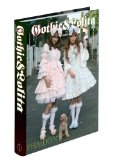 Gothic and Lolita
by Masayuki Yoshinaga, Katsuhiko Ishikawa.
Again the cover basically says it all – it's a book of photos of Japanese kids with unorthodox dress sense, but this time focused on different sub-cultures. Not as varied as Fruits, but there's still a big range of styles here.
Gothic and Lolita
by Masayuki Yoshinaga, Katsuhiko Ishikawa.
Again the cover basically says it all – it's a book of photos of Japanese kids with unorthodox dress sense, but this time focused on different sub-cultures. Not as varied as Fruits, but there's still a big range of styles here.


